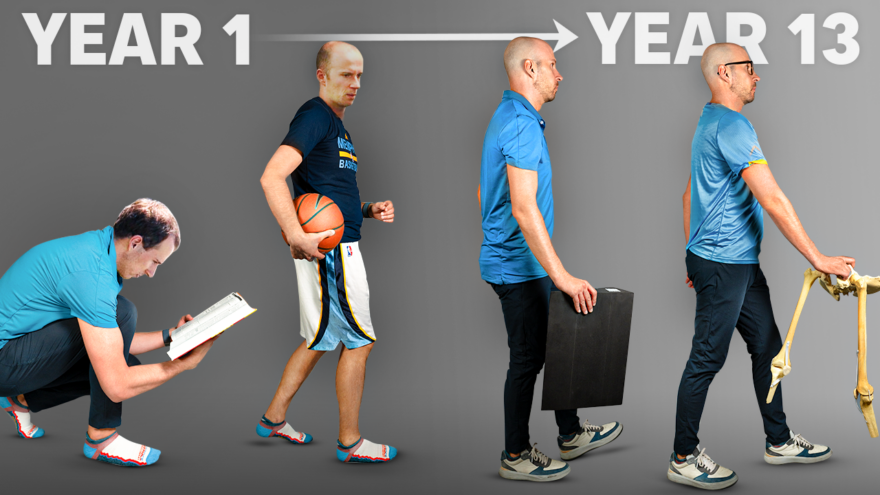Table of Contents
11 Lessons That’ll Help You Move and Feel Better
After 13 years as a physical therapist, from working in hospitals on one end to the NBA on the other, I’ve learned some crucial lessons. I’ve had great successes, and I’ve learned a lot from my failures too.
I’m going to share the lessons I’ve learned. These things will help you if you’re in pain, looking to move better, or help others do so.
Here’s how to approach movement in a smarter, more effective way.
1. Think Global, Not Local
Why do ten different exercises to address individual body parts when you could do two or three that improve it all? The body works as one cohesive unit—when you move one part, you affect everything.
The Key: Focus on movement patterns instead of isolating body parts. This doesn’t mean you ignore specific problem areas. Hell, you need to in actue injuries. But the real magic happens when you work on the entire movement system. Efficiency is everything.
2. Individualized Approach Is Key
Not everyone’s body functions the same. A ballerina and a powerlifter have WAY different movement needs. Their body structures have different movements available. Various strengths and limitations.
The best results come from assessing and designing a specific movement program.
Pro Tip: Ditch the generic protocols. Create a program built specifically for each individual to get faster, longer-lasting results. One size never fits all.
3. Movement is a Skill
People often ask, “How long will this exercise ‘stick’?” The problem is, exercises aren’t pills. They’re skills.
It’s just like learning a musical instrument. You don’t play chopsticks once and expect to become a piano master.
Takeaway: Practice movement needs consistently and at increasing intensities. If you treat movement like a process, you’ll see improvements that last. The mistake most people make is expecting quick fixes. But like anything worth mastering, it takes time and effort.
4. Exhaust All Conservative Measures First
Many people think surgery or medications will fix all their issues. But that often ignores the underlying factors contributing to pain. Poor sleep, nutrition, or even social isolation play a role in pain and overall health.
Why It Matters: Aggressive treatments can come with significant risks. Often, conservative measures like physical therapy yield similar long-term outcomes as surgery. Always try these first. Worst case scenario? You’ll be healthier going into surgery if it’s still necessary.
5. You Can’t Just Do X
Mobility drills are great, but they aren’t enough by themselves. Neither is lifting weights. You need a comprehensive approach that addresses ALL aspects of movement and fitness.
The Approach: Work on mobility, fitness, and play a sport. This covers all your bases and ensures you’re well-rounded mover.
6. It’s More Than Movement
Movement alone isn’t enough to stay healthy or pain-free. Humans are social creatures. Spending time with others boosts our immune system and overall well-being. Social connections, sleep, nutrition, and mental health are all equally important for physical health.
Real Talk: To be a healthy, pain-free human, you need to take care of your whole self—not just your body. Movement is one piece of the puzzle.
7. Posture Isn’t As Important As You Think
Posture problems are common, but obsessing over them can cause unnecessary stress. Everyone’s body is different.
What’s more important than having “perfect” posture is having the ability to move into many postures.
The Shift: Focus less on looking a certain way and more on being able to move comfortably and efficiently. Improving your movement range and patterns is far more valuable than fixing posture alone.
8. Manual Therapy Doesn’t Suck
Manual therapy is often misunderstood. It’s not about “breaking up scar tissue” or “putting joints back in place.” Instead, it’s an exercise regression—a way to help your body get into positions it can’t reach on its own.
Why Use It: Manual therapy can set the stage for movements your struggle doing. It’s an aid, not a solution in itself, but can be a game-changer when paired with the right exercises.
9. Pain Doesn’t Always Mean Damage
Pain is complex, and it doesn’t always equate to tissue damage. Pain is a signal, like a check engine light, indicating that something is off.
Imagine you party hard and wake up with a headache. Did you sustain a head injury and need to get imaging? There, you can see pain is NOT associated with damage.
On the flip side. Ever get caught up in something, then all-of-a-sudden notice you’re bleeding? Here, you have tissue damage, but no pain. You can see pain and damage don’t always match.
Golden Rule: Treat pain with respect, but don’t let it control you. Knock on the door of pain without breaking it down—meaning, work up to the point of pain and then back off. This strategy helps build tolerance and reduces fear around movement.
10. All Movement is Rotational
I learned this game-changing from my mentor, Bill Hartman: All movement is rotational.
There is either external or internal rotation occuring in all movements. This framework has simplified my approach, allowing me to target exactly what each person needs.
Simplified Insight: Figure out which rotation you need to improve. Identifying and addressing limited internal or external can drastically improve movement outcomes.
11. It’s Not Always Simple
While movement can be broken down into rotations and patterns, fixing it is still complex. There’s no one-size-fits-all solution. It requires continuous testing, adjusting, and trying different strategies until you find what works.
Final Thought
Improving movement isn’t about quick fixes—it’s a process of constant learning, practicing, and refining. These lessons took me years to understand, but now you can use them to improve your movement faster than ever.

